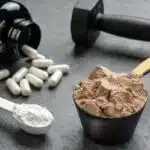Understanding Binge Eating Disorder and Food Addiction: Insights from the DSM-V Update
By Gabrielle Finora and the Team at LCWNS
The newest edition of the Diagnostic and Statistical Manual of Mental Disorders, or otherwise referred to as the DMS-V, recently refined the definition of Binge Eating Disorder (BED). The new definition sounds a lot like food addiction, another new condition currently being researched but not yet mentioned in the DMS-V. Let’s take a closer look at what connects these two disorders and how studying them both can lead to a better understanding of how they develop and better treatment options.
Binge Eating Disorder (BED) is defined in literature as repeated episodes of eating large quantities of food in a short period, followed by guilt and shame. Binges are not followed by compensatory behaviors, like purging or laxative abuse. This disorder encompasses five distinct characteristics: food addiction, night eating, binge eating, sweet eating, and prandial hyperphagia (intense, unsatisfiable hunger). While the disorder is new to the DSM, it is the most common eating disorder in the United States, estimated to affect 2.8 million adults (about 1.2% of the adult population). BED is currently estimated to affect 1.5% of women and 0.3% of men worldwide.
Similarly, food addiction is defined in literature as the search for pleasure in consuming highly palatable foods (often high in fat, sugar, and/or salt). These foods can trigger chemical reactions in the brain that release dopamine, coined as the happy hormone. A food addiction could look like needing to eat a certain amount of sugar per day or suffering from withdrawal symptoms like fatigue, headaches, or irritability. Negative emotions like chronic stress can have a detrimental impact on the hypothalamic-pituitary-adrenal connection, leading to an increased craving for highly palatable foods to experience the pleasurable release of dopamine. This can look like needing more sugar on a particularly stressful day to cope with the negative emotions. Notice how the timeframe of consuming the food is much larger than BED.
It is likely that an individual with BED also has a food addiction. In a study of 81 “obese” treatment-seeking BED patients using the Yale Food Addiction Scale (YFAS), 56.8% of participants were classified as food addicted. The two conditions share other similar qualities, such as lack of control and being easily influenced by mood and impulsivity. Other similarities include:
- Limited ability to abstain from or reduce use of problematic substance
- Increased levels of impulsivity
- Increased comorbidity with mood and anxiety disorders
- Triggered by cravings
- Similar neural-activation patterns
While BED and food addiction have similarities, evidence suggests they represent overlapping, but different conditions. Food addiction is just one part of BED. Additionally, BED is a mental health diagnosis, while food addiction is a separate condition not yet in the DSM-V. Some key differences between the two conditions are:
- BED specifies that consumption must occur during a discrete period. Food addiction does not.
- BED does not include a diagnosis that assesses withdrawal, tolerance, amount of time spent on food addiction (such as searching for, acquiring, purchasing, consuming, recovery).
- BED only considers the amount of food consumed, rather than the addictive properties of the substance.
- Food addiction treatment focuses on abstaining from the substance, while BED treatments do not promote abstinence (restriction could trigger more binging activity).
- BED has more focus on body shape and weight. Food addiction seeks to activate their pleasure and reward axis to cope with emotions.
Cognitive-behavioral therapy (CBT) is the best-established treatment for BED and food addiction. CBT monitors food consumption, develops coping strategies, identifies triggers, and recognizes automatic judgments and thoughts our brains make. One difference between the treatment of BED versus food addiction is abstinence. Abstaining from the addictive substance is critical for food addiction treatment because studies have shown that consuming even the smallest amount primes our brains to have more. BED treatment focuses on an “all-foods-fit” model because labeling foods as “off-limit” could increase the urge to binge.
It is important to specify what food addiction and BED are not. Colloquialisms often exaggerate very normal feelings or actions by referring to them as a condition. With the prevalence of diet culture and emphasis on certain eating behaviors in social settings, it is important to clarify what are and what are not behaviors of concern.
BED is not:
- Overeating on special occasions like holidays, anniversaries, or birthdays
- Feelings of fullness after a meal
- Eating past fullness if you particularly enjoy a meal
- Going back for a second or third helping of a meal.
- Eating a large meal after not eating for a long period of time where the act of eating was not permitted (like a very busy workday or problems accessing food)
- Eating a snack before bed when hungry
Some phrases that misrepresent a binge episode:
- “I binged on Thanksgiving. I ate two full plates of dinner.”
- “At my birthday dinner, I had an appetizer, entrée, and dessert. I totally binged.”
- “Work was crazy, I didn’t even have time to eat lunch. So, when I got home, I binged on two whole plates of dinner. I was so hungry”
Food addiction is not:
- Craving a sweet snack after a meal
- Eating a lot of something because of hunger
- Eating a lot of something because you like it
Some phrases that misrepresent food addiction:
- “I have to have a sweet treat after dinner. It’s automatic.”
- “Every day, I drink these juices or else I go crazy!”
- “I love these granola bars; I could eat them everyday and not get tired of the taste”
More research is needed to develop a deeper and more complete understanding of BED and food addiction. The relationship between these conditions, among other eating disorders, can provide insight into how food-related medical conditions such as “obesity”, high blood pressure, and heart disease develop and persist throughout communities; and how to streamline treatment options for more successful rehabilitation.
For readers interested in exploring treatment options and learning more about nutrition and wellness in the context of these disorders, Laura Cipullo’s Whole Nutrition Services offer a range of holistic approaches.
If you or someone you know is struggling with symptoms related to BED or food addiction, resources like Eating Disorder Hope and Food Addicts Anonymous offer valuable information and support including a quiz to evaluate your symptoms and get help anonymously.
References:
Binge Eating Disorder. National Eating Disorders Association.
https://www.nationaleatingdisorders.org/learn/by-eating-disorder/bed
Gearhardt, A. N., White, M. A., & Potenza, M. N. (2011). Binge Eating Disorder and Food
Addiction. Current drug abuse reviews, 4(3), 201. https://doi.org/10.2174/1874473711104030201
Giel, K. E., Bulik, C. M., Fernandez-Aranda, F., Hay, P., Keski-Rahkonen, A., Schag, K.,
Schmidt, U., & Zipfel, S. (2022). Binge eating disorder. Nature reviews. Disease primers, 8(1), 16. https://doi.org/10.1038/s41572-022-00344-y
Gutierrez, N. (2023, May 8). Binge eating disorder facts, statistics, prevalence, diagnosis and treatment. The Recovery Village Drug and Alcohol Rehab. https://www.therecoveryvillage.com/mental-health/binge-eating/binge-eating-statistics/
Kalon, E., Hong, J. Y., Tobin, C., & Schulte, T. (2015). Psychological and Neurobiological
Correlates of Food Addiction. International review of neurobiology, 129, 85. https://doi.org/10.1016/bs.irn.2016.06.003
Segura-Garcia, C., Aloi, M., Rania, M., Carbone, E. A., Taverna, S., Papaianni, M. C., Liuzza,
- T., & Fazio, P. D. (2021). Development, validation, and clinical use of the Eating Behaviors Assessment for Obesity (EBA-O). Eating and Weight Disorders, 27(6), 2143-2154. https://doi.org/10.1007/s40519-022-01363-0






